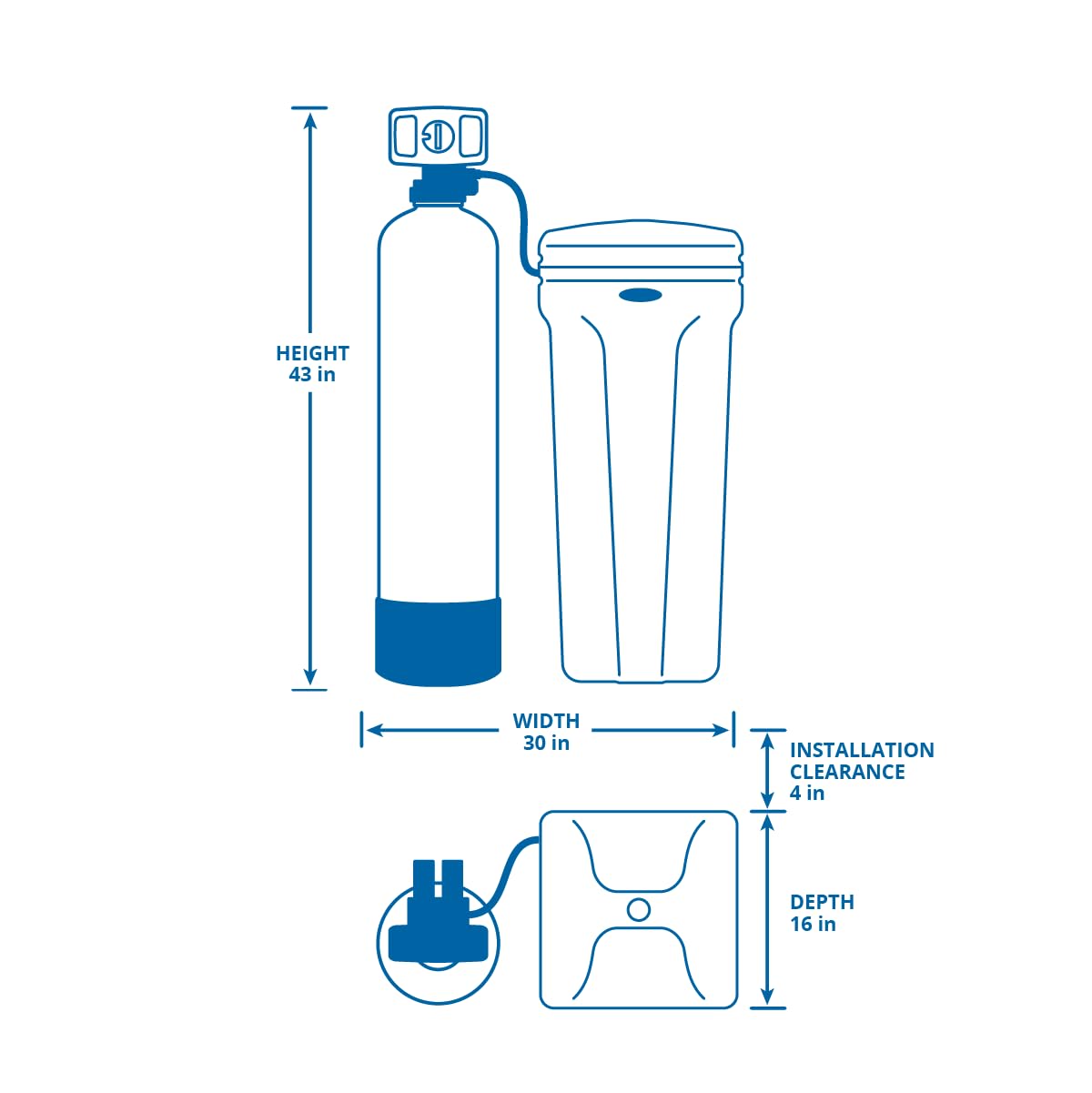Looking for a reliable whole-house solution to reduce hard water and protect your plumbing and appliances?
Quick verdict
You’ll get dependable whole-home soft water with the Aquasana SimplySoft® 40,000 Grain Water Softener – Whole House Hard Water Reduction – Base Tank & Cabinet System WH-SF40-BASE. It’s designed for typical families (up to 5 people and 4 bathrooms) and balances efficiency with relatively low maintenance thanks to its metered regeneration and user-friendly LCD.
What the Aquasana SimplySoft® 40,000 Grain Does
This system reduces the minerals that cause hard water so you get scale-free water at every tap in your home. It uses ion exchange to soften both city and well water, making showers, laundry, dishes, and appliances perform better and last longer.
Why you’d want soft water
Soft water eliminates scale buildup inside pipes and appliances, so you’ll likely see improved water heater efficiency and fewer repair calls over time. You’ll also notice softer skin and hair after showers, and cleaner, spot-free dishes and glassware.
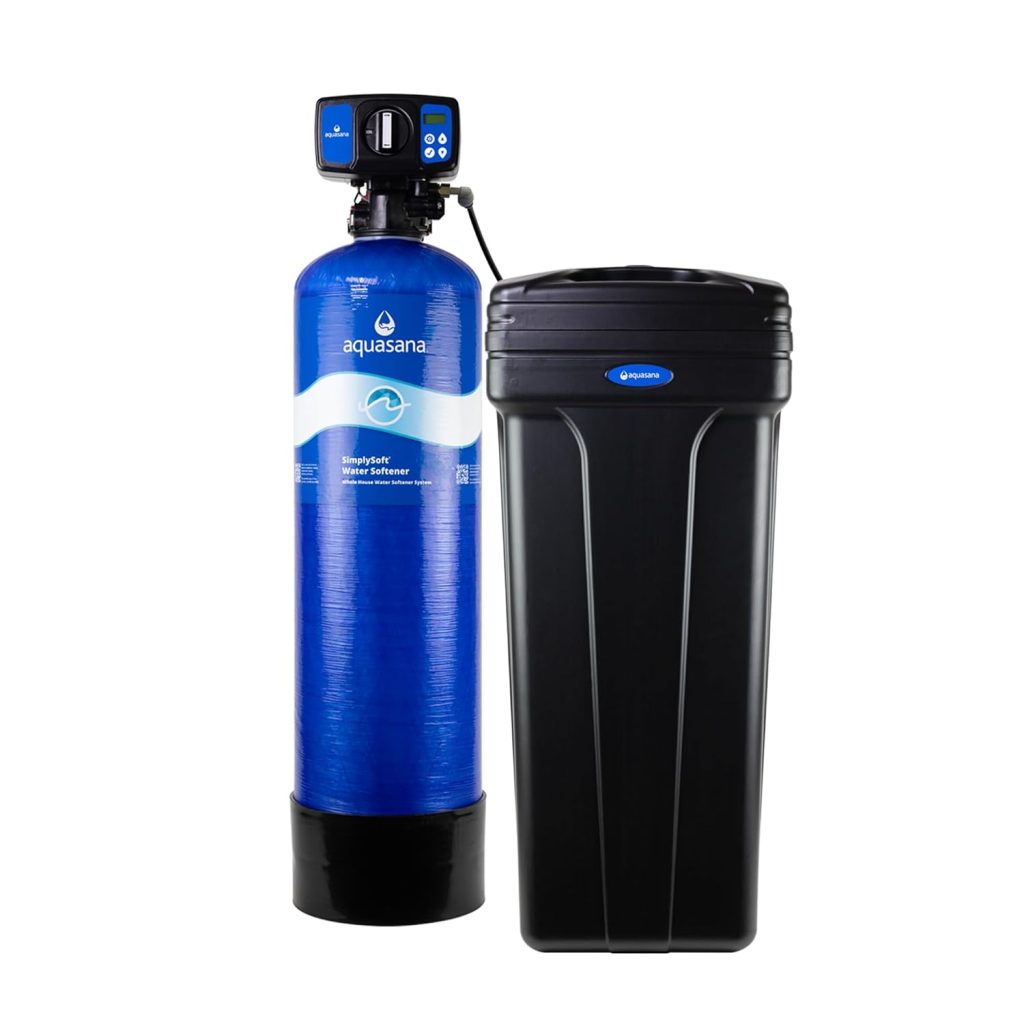
Specifications and quick facts
Below is a concise table that breaks down the most important specs and selling points so you can quickly see if this system fits your needs. These are the manufacturer’s core highlights and seller-provided details so you can compare at a glance.
| Feature | Detail |
|---|---|
| Product name | Aquasana SimplySoft® 40,000 Grain Water Softener – Whole House Hard Water Reduction – Base Tank & Cabinet System WH-SF40-BASE |
| Capacity | 40,000 grain (designed for typical household use up to 5 people and 4 bathrooms) |
| Operation | Ion exchange softening with metered or time-based regeneration |
| Salt & water savings | Metered mode uses up to 50% less salt and 28% less water vs. standard time-based regeneration (manufacturer claim) |
| Certifications | IAPMO certified to NSF/ANSI Standard 44 for reduction of water hardness; certified to CSA B483.1 |
| Warranty | 5/10-Year Limited Warranty |
| Use | Suitable for city or well water |
| Optional accessories | Installation kit and pre-filter recommended (Aquasana Softener Installation Kit sold separately, ASIN B0DHFMJHK6) |
| Customer support | Call 866-662-6885 for service and installation support |
How it works
You’ll get ion exchange softening, which is a proven method for removing hardness minerals like calcium and magnesium from your water. The system traps hardness ions on a resin and periodically regenerates the resin with a salt brine so it can continue removing minerals.
Metered vs time-based regeneration
The SimplySoft includes an LCD controller that supports metered operation, meaning it regenerates only when you’ve actually used water. Metered regeneration helps you save salt and water by avoiding unnecessary regenerations, especially if your household usage varies week to week.
Resin and salt basics
Resin beads are the heart of the system and they swap hardness ions for sodium or potassium ions during treatment. You’ll need to maintain a salt supply for the brine regeneration cycle, and the system’s metered mode reduces how often you add salt compared to older time-clock systems.
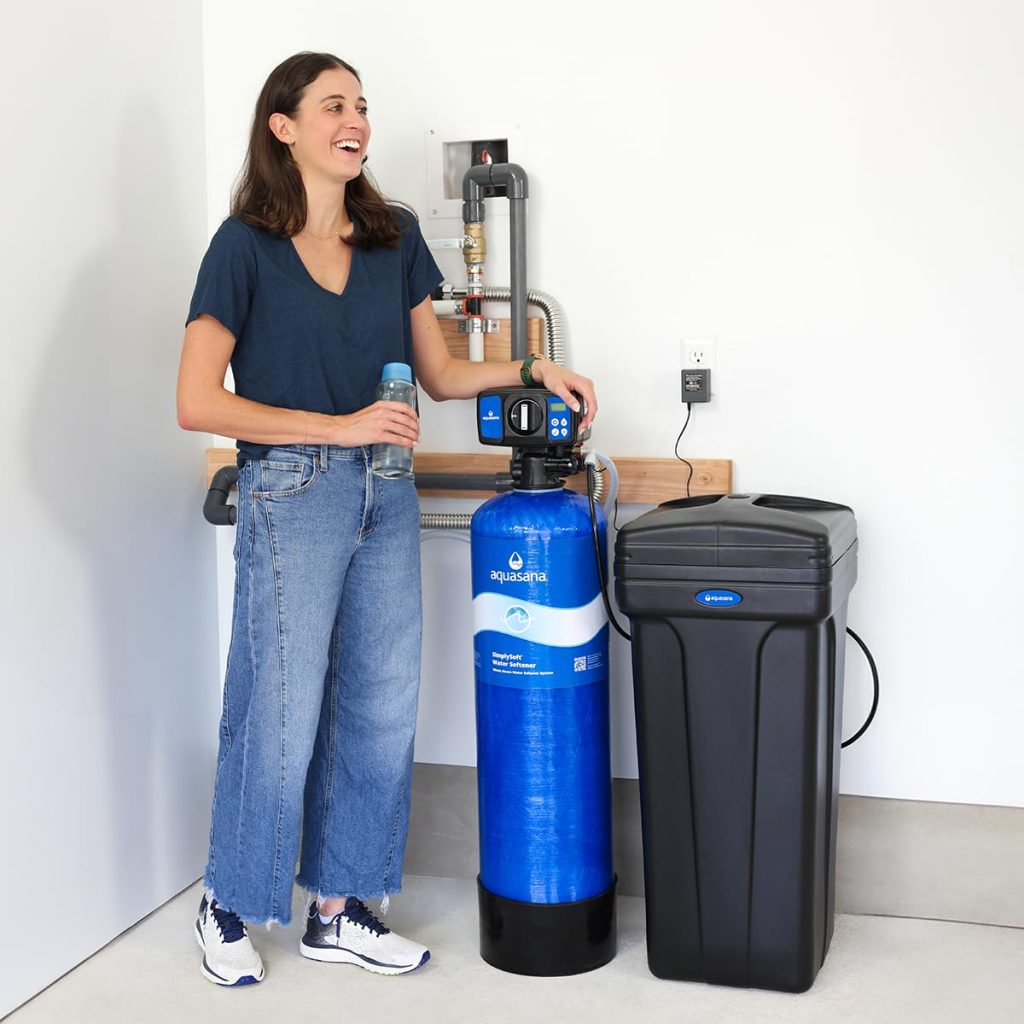
Key features and benefits
You’ll appreciate that this system is designed to balance performance with convenience and efficiency, and it’s meant to protect your home from the costly effects of hard water. The experience of soft water extends beyond appliances — it’s something you’ll notice every day on your skin, hair, and linens.
- Whole-house coverage: soft water from every tap and shower head.
- 40,000-grain capacity: sized to handle average family demand up to 5 people and 4 bathrooms.
- Metered regeneration: uses water/usage data to regenerate only when required.
- LCD controller: user-friendly display for settings and status updates.
- Certified performance: tested to NSF/ANSI 44 and CSA B483.1 for hardness reduction.
- Compatibility: works with city or well water when pre-filtered as recommended.
- Warranty and support: 5/10-Year Limited Warranty and dedicated customer service line.
Skin, hair, and cleaning benefits
You’ll likely notice softer, less irritated skin and smoother hair since soaps and shampoos lather and rinse more effectively in soft water. Your clothes and linens will feel softer and retain color longer because scale doesn’t deposit in fabric the way hard water can.
Appliance and plumbing protection
By preventing scale buildup inside water heaters, dishwashers, washing machines, and pipes, the softener helps maintain appliance efficiency and reduces the frequency of repairs. That can translate into tangible long-term savings on energy and maintenance.
Installation and setup
You’ll need some clear space near your main water line, a drain for regeneration discharge, power for the electronic controller, and access to the brine/salt area for maintenance. The system ships as a base tank and cabinet, and Aquasana recommends a pre-filter (sold separately) to protect the softener resin and improve longevity.
Typical installation steps
You’ll first shut off the main water and drain the lines to prevent air pockets during installation. Next, you’ll connect the inlet and outlet plumbing, set up the drain line and overflow, program the control valve and either add salt and start the system or schedule a professional to perform those final steps if you’d rather not DIY.
Should you hire a pro?
If you’re comfortable with basic plumbing and electrical hookups, you can install many whole-house systems yourself, but hiring a licensed plumber ensures correct placement, secure drain connections, and code compliance. Professional installation also helps if you need softener sizing adjustments based on measured water hardness and household flow rates.
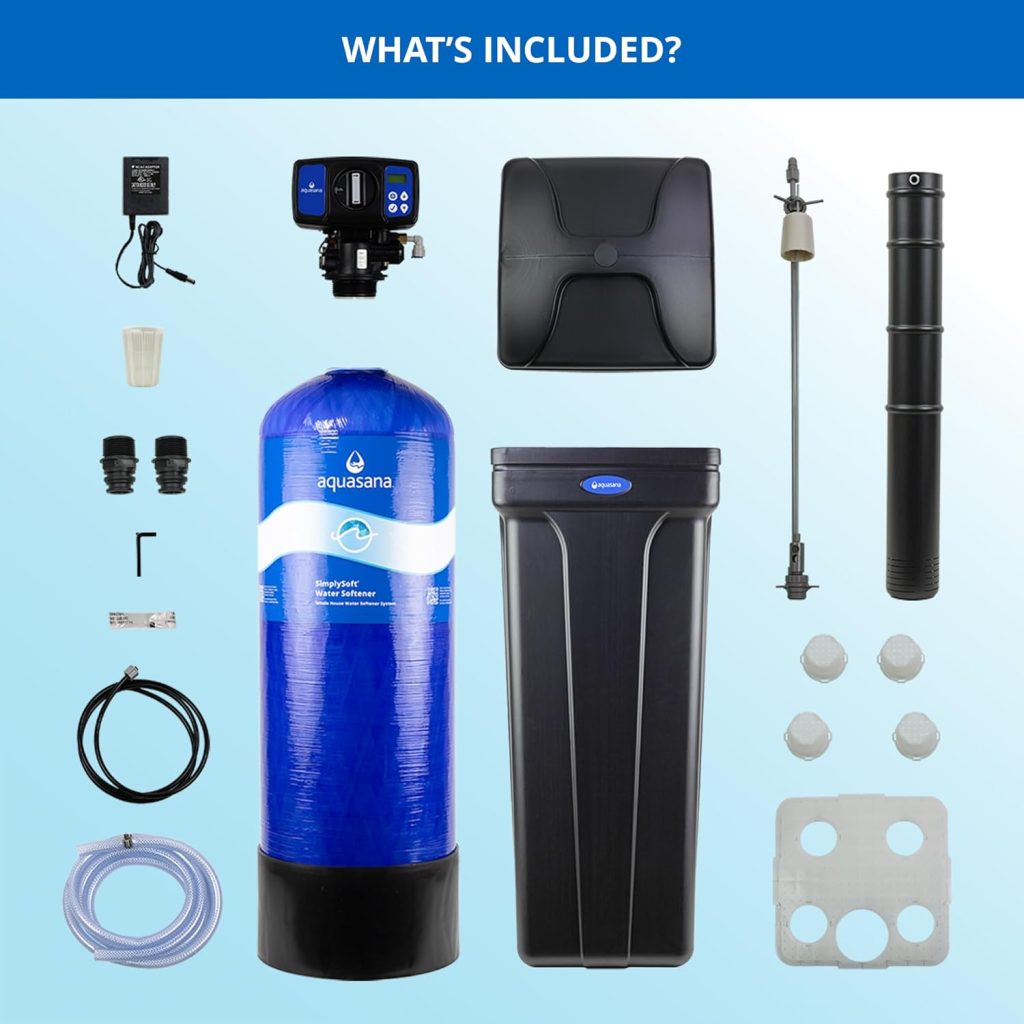
Maintenance and upkeep
You’ll perform routine tasks like topping off salt in the brine tank and occasionally checking settings and drain lines to ensure smooth operation. Regular maintenance helps avoid downtime and preserves the softener’s effectiveness.
Salt management
Check the salt level in the brine tank periodically and refill as needed, typically once a month depending on household usage and water hardness. Since metered regeneration reduces salt usage, you’ll likely refill salt less frequently than with older time-based systems.
Resin longevity and care
Resin typically lasts many years if not exposed to excessive chlorine, iron, or sediment. If your water has high iron, sediment, or chlorine levels, use a recommended pre-filter or conditioning step to protect the resin and prevent premature fouling.
Performance expectations
You’ll notice less scale on faucets, glassware, and shower doors, and appliances should run more efficiently over time. The degree of benefit depends on your starting water hardness level and how you use water in your home.
Typical household results
For many households that test in the moderate-to-high hardness range, switching to a 40,000-grain system of this size should dramatically reduce visible scale and extend appliance life. Your actual results will be influenced by initial hardness, water usage patterns, and whether you follow recommended maintenance schedules.
When results may vary
If your water contains heavy sediment, iron, or manganese, you may need pre-treatment to get the best long-term results from the softener. Extremely large households or properties with very high hardness may need a larger capacity or a dual-tank setup for continuous service during regeneration cycles.
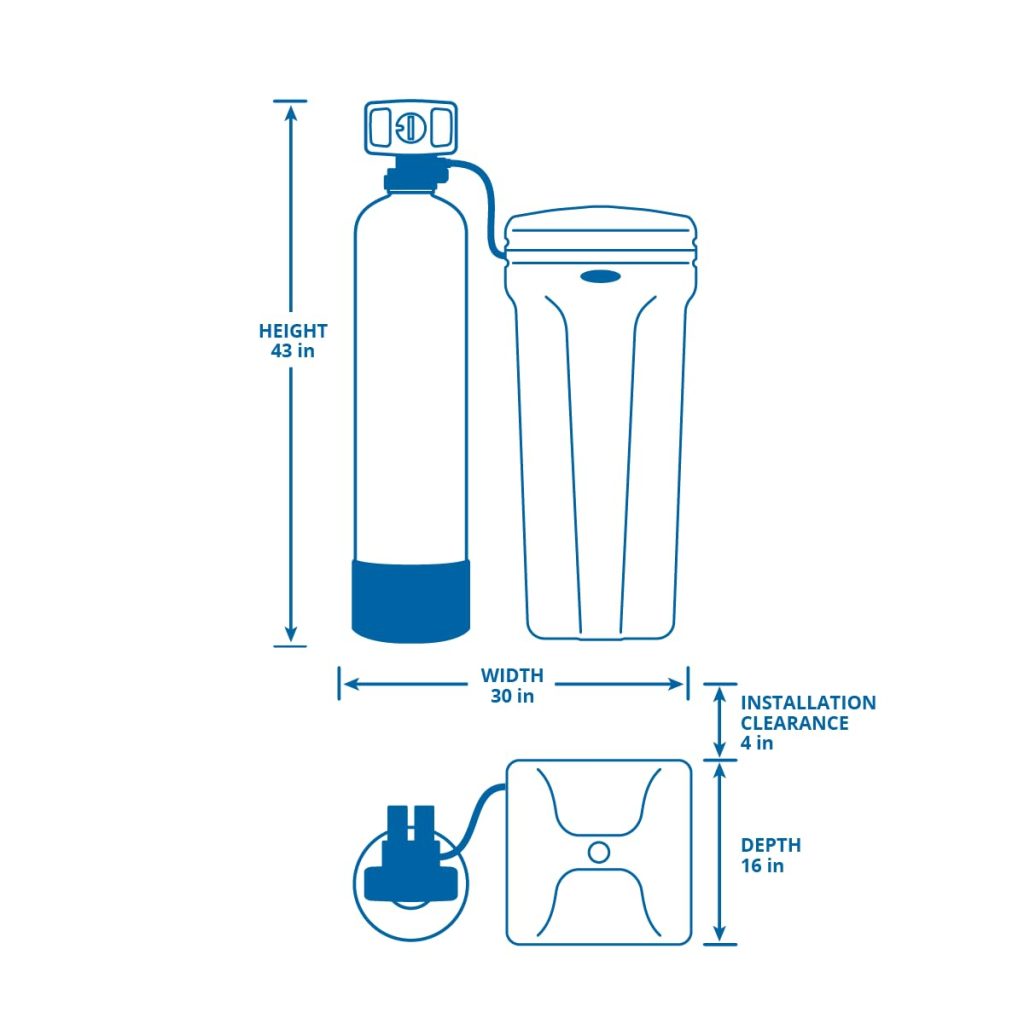
Troubleshooting common issues
If you ever run into problems, many typical softener issues have straightforward fixes you can try before calling support. Keep basic tools and the owner’s manual handy so you can check settings and connections quickly.
Common symptoms and fixes
If you notice hard water returning, check the salt level, ensure the unit is powered and programmed correctly, and confirm the regeneration cycle has been running. If there are flow restrictions or pressure drops, inspect inlet screens and pre-filters for clogs and verify plumbing connections are properly sized for flow rate.
When to contact support
If you see persistent iron fouling, resin leakage, or electronic/controller malfunctions, call Aquasana support at 866-662-6885 for guidance and potential warranty service. For installation-related problems or plumbing code concerns, contact a licensed plumber to confirm everything meets local requirements.
Who this system is best for
You should consider this system if you live in a typical family home with up to five occupants and up to four bathrooms, and you want proven hardness reduction across the whole house. It’s also a solid choice if you appreciate an electronic control head that conserves salt and water through metered regeneration.
Homes with city or well water
The softener is designed for both city and well water supplies, but if your well water has high sediment, iron, or biological contaminants you’ll want to add recommended pre-filtration. The optional Aquasana Softener Installation Kit and pre-filter help protect the system and maintain resin life.
Households looking to reduce cleaning and repair costs
If you’re tired of hard-water spots, dry skin, stiff laundry, and the costs of scale-related repairs, you’ll likely find this system reduces many of those headaches. The water savings and lower soap usage also contribute to everyday convenience and potential cost reductions.
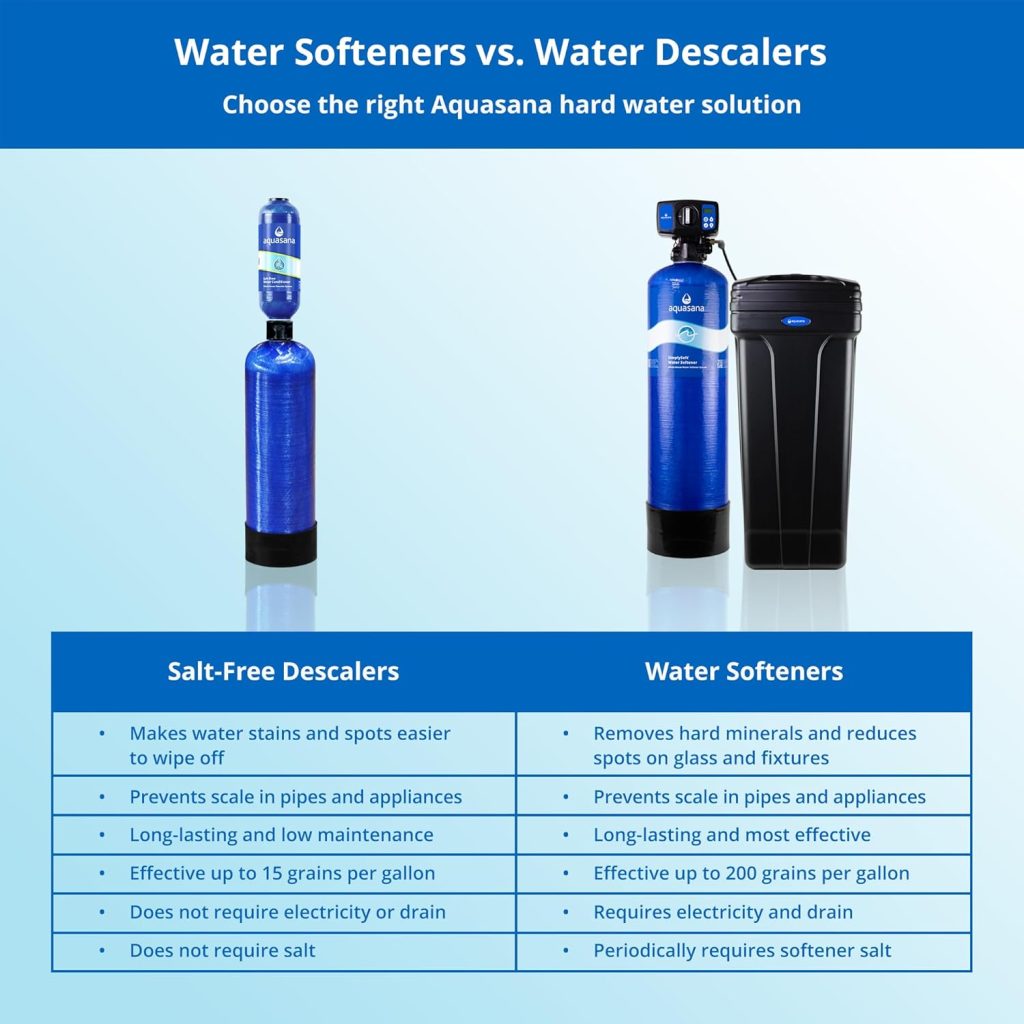
Cost and value considerations
You’ll pay for the initial hardware, possible professional installation, ongoing salt purchases, and periodic check-ups, but you may recoup value through reduced energy use, fewer repairs, and lower detergent consumption. The metered operation aims to reduce ongoing salt and water expenses compared to older time-clock units.
What to budget for
Besides the purchase price, budget for salt (typically rock salt or solar salt), an occasional pre-filter cartridge replacement, and any optional installation kit or professional labor. Costs for salt and filters vary by region and household usage, so track your initial months of consumption to estimate annual operating costs.
Long-term value
Soft water can prolong the life of water heaters and other appliances, and many owners report lower cleaning costs and better laundry results. The degree of long-term savings depends on how hard your water is now and how much scale has already accumulated in your system.
Comparison with other softener types
You’ll want to compare salt-based ion exchange systems like this one with salt-free conditioners, electronic descalers, and dual-tank softeners. Each approach has trade-offs in performance, maintenance, and cost.
Salt-based ion exchange vs salt-free conditioners
Ion exchange (what SimplySoft uses) actually removes the hardness minerals, so you get true soft water that rinses cleaner. Salt-free systems condition scale but don’t remove calcium and magnesium, so they’re often better for low to moderate hardness or for people avoiding added sodium.
Dual-tank and demand-initiated systems
If you need continuous soft water without downtime during regeneration, a dual-tank system gives uninterrupted service but typically costs more and may use more salt. The SimplySoft’s metered regeneration reduces waste and can be a good middle ground for most households.
Pros and cons
You’ll want to weigh both the strengths and limitations so you can decide whether this model fits your priorities and budget. Below is a concise look at the major pros and cons based on features and typical owner experiences.
Pros:
- Effective hardness reduction certified to NSF/ANSI Standard 44.
- Metered regeneration that can save salt and water.
- User-friendly LCD controller for easier operation.
- Designed for whole-house coverage for homes up to ~5 people, 4 bathrooms.
- Works with city or well water when used with recommended pre-filters.
- 5/10-Year Limited Warranty and manufacturer support.
Cons:
- Requires periodic salt purchases and brine maintenance.
- Pre-filter sold separately (recommended for many water types) which adds cost.
- Not a “no-maintenance” solution — routine checks are needed.
- For very large households or extremely hard water, a larger or dual-tank system may be preferable.
Installation kit and pre-filter recommendation
While the base tank and cabinet system include the essential softener components, Aquasana recommends using the optional pre-filter in their Softener Installation Kit (sold separately on Amazon, ASIN B0DHFMJHK6). The pre-filter helps keep sediment and chlorine away from the resin and prolongs performance.
Why you’d add a pre-filter
If your water has sediment, iron, or higher levels of chlorine, the pre-filter prevents fouling of the resin bed and reduces maintenance frequency. Installing a pre-filter is a relatively small additional expense that can substantially protect the softener and improve long-term value.
Warranty and customer support
You’ll have peace of mind with Aquasana’s 5/10-Year Limited Warranty and access to a customer service line for help with installation and troubleshooting. Keep your purchase documentation handy and call 866-662-6885 if you need help with setup or questions about coverage.
What to expect from warranty coverage
The limited warranty typically covers defects in materials and workmanship but check the fine print for specific terms and any requirements like professional installation for full coverage. If you encounter a defect within the warranty period, contact customer service to begin the claim process.
Final recommendation
If you want a proven ion exchange softener for a typical family home and you value reduced salt and water waste through metered regeneration, the Aquasana SimplySoft® 40,000 Grain Water Softener – Whole House Hard Water Reduction – Base Tank & Cabinet System WH-SF40-BASE is a solid option. Pair it with the recommended pre-filter and consider professional installation if you want the fastest, most reliable setup with code-compliant plumbing.
How to decide if it’s right for you
You should test your water hardness first, compare the system’s capacity and regeneration features with your household size and usage patterns, and factor in the cost of any necessary pre-filtration. If you’re in the target household range and want true soft water benefits across your home, this system will likely meet your needs.
Frequently asked questions
How often do I need to add salt?
You’ll usually add salt based on your household’s water usage and hardness level, often monthly or every few months for typical families, though metered operation reduces frequency. Monitor the salt tank and top it up before it drops below the brine line to avoid issues with regeneration.
Will this system add sodium to my water?
Ion exchange softeners replace hardness ions with sodium (or potassium if you use potassium chloride salt), so a small amount of sodium will be present in softened water. The sodium increase is generally low and often negligible for most people, but if you have strict sodium dietary concerns, consider testing the softened water or consult your physician.
Can I use potassium chloride instead of salt?
Yes, you can typically use potassium chloride as an alternative to sodium-based salt in ion exchange softeners, though it’s usually more expensive. Using potassium chloride will reduce sodium addition to your water while maintaining softening performance, but check your owner’s manual and supplier guidance for compatibility and dosing.
Do I need a drain connection?
Yes, the softener requires a drain for the regeneration discharge cycle so you’ll need a suitable waste connection nearby. Ensure the drain line meets local code requirements and doesn’t have obstructions or backflow risks.
Can the system handle well water?
Yes, the system is suitable for well water, but if your well has sediment, iron, or biological contaminants you should add a pre-filter or iron filter. The recommended Aquasana pre-filter and proper well water testing will help protect the resin and ensure long-term performance.
How long will the resin last?
With proper pre-filtration and routine maintenance, resin typically lasts many years, though heavy iron or chlorine exposure can shorten its lifespan. If you notice declining softening performance over time, have your water tested and check for resin fouling or other issues.
Additional buying tips
Before purchasing, test your water hardness and note household flow needs so you can confirm the capacity matches your usage. Factor in the optional pre-filter and potential installation costs, and consider whether you want professional installation for peace of mind and code compliance.
What to check before installation
Verify spatial clearances for the base tank and cabinet, location of a drain and electrical outlet, and accessibility for salt refills and control adjustments. Confirm the installation path for inlet/outlet plumbing and ensure you’ll be able to service the unit without tight or awkward access.
Closing thoughts
You’ll find the Aquasana SimplySoft® 40,000 Grain Water Softener – Whole House Hard Water Reduction – Base Tank & Cabinet System WH-SF40-BASE to be a balanced choice for whole-home softening, offering certified hardness reduction, a user-friendly LCD controller, and salt/water savings with metered regeneration. By pairing it with the recommended pre-filter and following good maintenance practices, you’ll get soft, scale-free water that protects your home and makes everyday cleaning and bathing more pleasant.
Disclosure: As an Amazon Associate, I earn from qualifying purchases.


